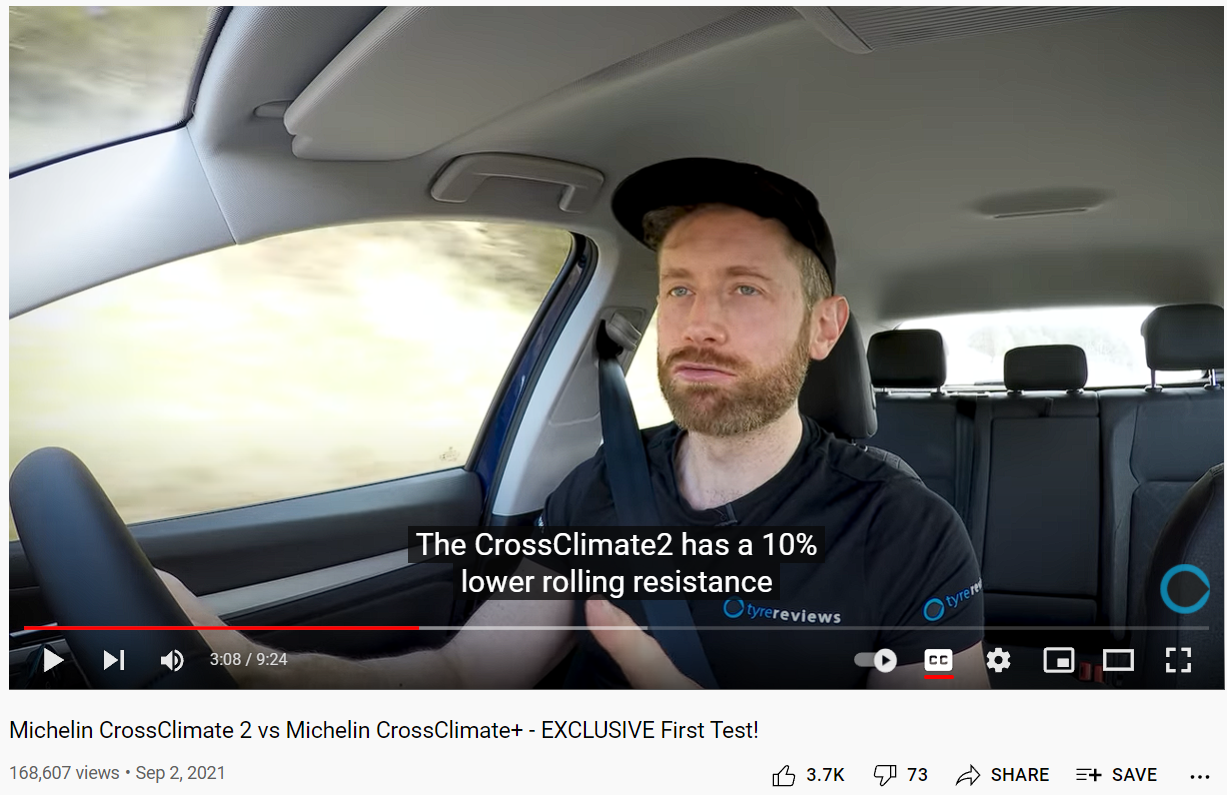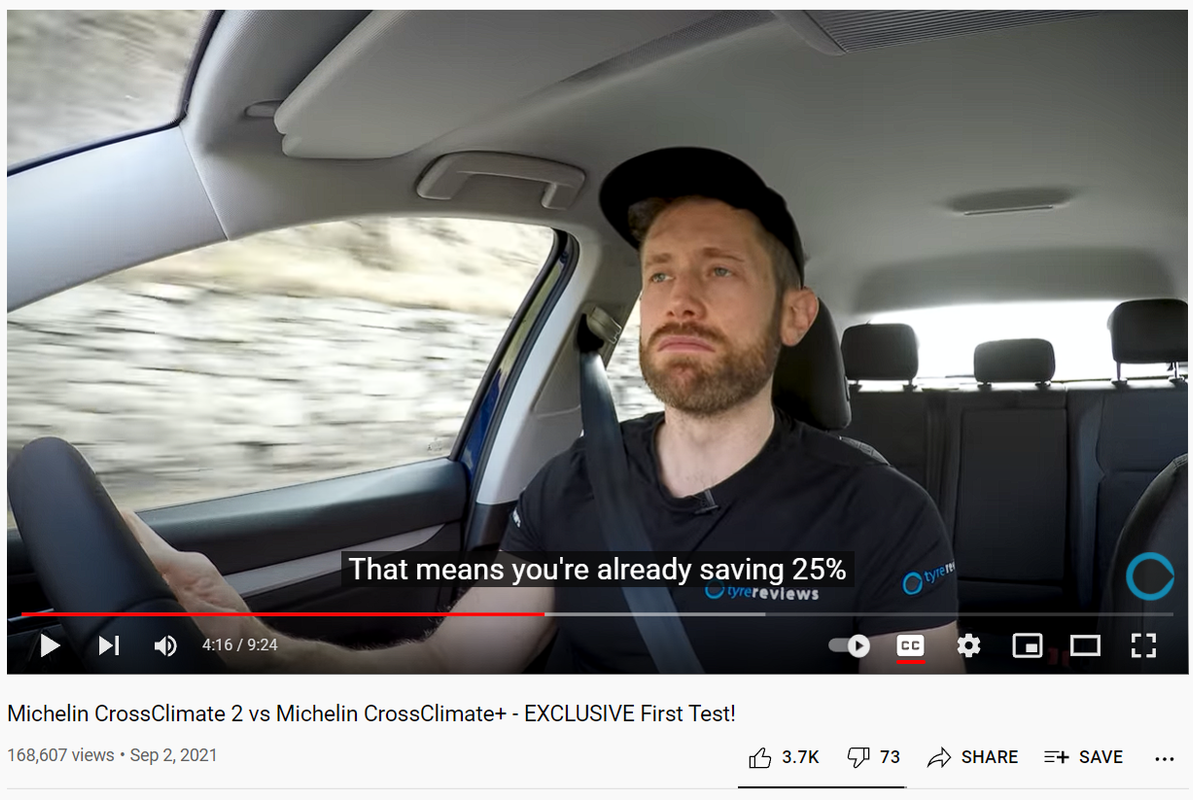You are using an out of date browser. It may not display this or other websites correctly.
You should upgrade or use an alternative browser.
You should upgrade or use an alternative browser.
**Unofficial Tyre Thread**
- Thread starter rossk26
- Start date
More options
Thread starter's postsDon
- Joined
- 20 Oct 2002
- Posts
- 34,921
- Location
- Oxfordshire / Bucks
CC's are good on fuel tbh
Soldato
- Joined
- 23 Nov 2004
- Posts
- 10,646
I've ordered some CC2 to be fitted next week. I now live up higher than before and tend to get more snow than before even at 400ft difference.
Anything would be better than a Eagle F1 AS5 in the snow I imagine.
Anything would be better than a Eagle F1 AS5 in the snow I imagine.
I'm going to go from 215/50/17 to 215/55/16 with the winter tyres.
I assume I won't have to do anything else with alignment etc?
According to the eTyres calculator, the total difference in circumference and diameter is <0.87% and the actual speed at 100 Km/h will be 99.1 Km/h — so it doesn't appear to make enough of a difference to warrant any additional faff.
Or have I missed something?
I assume I won't have to do anything else with alignment etc?
According to the eTyres calculator, the total difference in circumference and diameter is <0.87% and the actual speed at 100 Km/h will be 99.1 Km/h — so it doesn't appear to make enough of a difference to warrant any additional faff.
Or have I missed something?
Associate
- Joined
- 17 Dec 2015
- Posts
- 329
Guys, what about the fuel consumption on different sets of tyres? Do you measure your fuel consumption? Do you expect lower fuel consumption depending on the tyres' rating?
I recall reading that the difference in fuel consumption between an A rated tyre and a G rated tyre was about 8%, so about just over 1% per letter band. For a car that does say 50mpg, this would equate to about 0.5mpg for each letter band difference. This is well within margin of error, and you'll get more variation based on the weather (temperature, wind and rain), but over the life of the tyre it can add up. If you swapped for much more efficient tyres and had a 5% difference and the life of the tyre was 20,000 miles, then at 50mpg you would use 400 gallons of fuel. But at 52.5mpg, you would only use 380 gallons. At about £5.70 per gallon, the total savings would work out to about £100, or £25 per tyre. Not enough to pay for the tyre, but enough of a difference to maybe allow you to go for a more premium tyre which has a higher initial purchase price.
I recall reading that the difference in fuel consumption between an A rated tyre and a G rated tyre was about 8%, so about just over 1% per letter band. For a car that does say 50mpg, this would equate to about 0.5mpg for each letter band difference. This is well within margin of error
No, the numbers that you add here are just way way off the real tests.
With CrossClimate 2, it is said that drivers could save the cost of one of tyres over the lifetime of the tyres. That is 25% saving!


I recall reading that the difference in fuel consumption between an A rated tyre and a G rated tyre was about 8%, so about just over 1% per letter band. For a car that does say 50mpg, this would equate to about 0.5mpg for each letter band difference. This is well within margin of error, and you'll get more variation based on the weather (temperature, wind and rain), but over the life of the tyre it can add up. If you swapped for much more efficient tyres and had a 5% difference and the life of the tyre was 20,000 miles, then at 50mpg you would use 400 gallons of fuel. But at 52.5mpg, you would only use 380 gallons. At about £5.70 per gallon, the total savings would work out to about £100, or £25 per tyre. Not enough to pay for the tyre, but enough of a difference to maybe allow you to go for a more premium tyre which has a higher initial purchase price.
Wrong. Its 3-4% PER LETTER so up to 28% between A and G. Thats a lot and very noticable. Some really good tyres performance wise can be D for fuel compared with perhaps another decent tyre at B so 6-8% difference.
Wet braking is 3-6m per letter which again is a massive amount so up to 18m between an A tyre and an E tyre.
I have no idea who even buys E rated tyres in the UK? They must be mad.
Those stickers of ratings are being put by manufacturers. It would have more credit if an independent body did. I think it is all marketing bs. Btw i loath that guy from tyre reviewsI recall reading that the difference in fuel consumption between an A rated tyre and a G rated tyre was about 8%, so about just over 1% per letter band. For a car that does say 50mpg, this would equate to about 0.5mpg for each letter band difference. This is well within margin of error, and you'll get more variation based on the weather (temperature, wind and rain), but over the life of the tyre it can add up. If you swapped for much more efficient tyres and had a 5% difference and the life of the tyre was 20,000 miles, then at 50mpg you would use 400 gallons of fuel. But at 52.5mpg, you would only use 380 gallons. At about £5.70 per gallon, the total savings would work out to about £100, or £25 per tyre. Not enough to pay for the tyre, but enough of a difference to maybe allow you to go for a more premium tyre which has a higher initial purchase price.

Done around 1200 miles on my cross climate 2s and they started at 7mm, they are at either 6.5mm or 6.7mm, will have to have a closer look in the daylight/drier weather than today.
So if it's 6.5mm then I'm looking at 12,000 miles to hit 2mm right?. Or if it's 6.7mm, 20,000 miles?
I'll have a proper look when I'm next off and get a more accurate mileage, but they don't seem to be wearing very well, unless I'm missing something?
Ok so had a proper look today, pressures are fine. Fronts are around 6.4mm. Rears are around 6.6mm. Mileage done on them is : 1312miles.
Hopefully the wear stabilises, and I'll definitely be rotating my tyres.
Those stickers of ratings are being put by manufacturers. It would have more credit if an independent body did. I think it is all marketing bs. Btw i loath that guy from tyre reviews
There are pretty specific testing standards the tyre manufacturers have to go to in order to come up with their stickers.
And since some premium tyres have D or even E ratings on them, I'm not sure the manufacturer is lying when they are the ones stating their tyre is **** in the wet or at fuel economy,
I just think most of the public dont realise that the difference on the fuel equates to 0.1l per 100km in consumption so A to E is potentially 0.5l per 100km and at todays prices that can mean 75p per 100km. That can be as much as £240 per annum on somebody doing 20,000 miles.
Or that each band on the wet braking is up to 6m further braking distance. Perhaps is more people realise the difference, people might select their tyres differently?
Associate
- Joined
- 17 Dec 2015
- Posts
- 329
Wrong. Its 3-4% PER LETTER so up to 28% between A and G. Thats a lot and very noticable. Some really good tyres performance wise can be D for fuel compared with perhaps another decent tyre at B so 6-8% difference..
3-4% difference in rolling resistance per letter, but I was was talking about differences in fuel consumption. I wish we did get a 28% improvement in fuel consumption moving from a G rated tyre to an A rated one

3-4% difference in rolling resistance per letter, but I was was talking about differences in fuel consumption. I wish we did get a 28% improvement in fuel consumption moving from a G rated tyre to an A rated one
G to A doesnt exist anymore, its only A to E and now its officially its 0.1l per 100km for each step in the band not rolling resistance which is only 20% of your fuel consumption. 10l per 100km is considered average ffrom googling so with the new bands it actually means 1% fuel consumption per band to a maximum of 5% from A to E.
Still means a saving of £240 per annum for a 20,000 per year car so basically between an A and an E tyre its like one or two free tyres per year from the fuel saving.
Interesting numbers regarding the fuel consumption of the rated tyres, it must also increase the available range for electric cars. That should be a new rating for tyres seeing as we'll all be driving milk floats sooner or later.
Indeed. Same with tyre sizes. I noticed with the online configator on BMW as you changed the wheels and tyre sizes then actual mpg went down. It will be the same with EV cars.
Don
- Joined
- 20 Oct 2002
- Posts
- 34,921
- Location
- Oxfordshire / Bucks
has anyone watched Jons latest video on winter tyres ?
i found it rather interesting in many factors
but one thing that did stick out for me, Jon fits Summer tyres, then in winter he switches to no not winter tyres, all season tyres !
i found it rather interesting in many factors
but one thing that did stick out for me, Jon fits Summer tyres, then in winter he switches to no not winter tyres, all season tyres !
Having F1AS5's fitted tomorrow, should make a big difference compared to the unknown things that are fitted currently.
Had them fitted earlier today. Have to say the service from TyresOnTheDrive / Halfords was superb.
Any change in road noise?Had them fitted earlier today. Have to say the service from TyresOnTheDrive / Halfords was superb.


